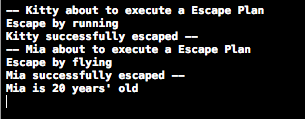I came across the Protocol-Oriented programming concept recently and I found it quite fascinating, so I decided to rewrite my previous story with protocols and value-based approaches.
The first thing I need to do is layout all the requirements:
- I want to model all the creatures in the world including animals and plants.
- Basically all creatures have names. The difference between animals and plants is whether they can move, generally speaking.
- All the moving animals have their own ‘Escape Strategy’. But how do they execute their strategies varies.
//: Create the base protocol 'Creature'
public protocol Creature: CustomStringConvertible {
static var entityName: String { get }
var name: String { get }
var canMove: Bool { get }
}
//: Protocol 'Animal' inherit from 'Creature' protocol and it has a 'escapeStrategy', can 'performEscape'
public protocol Animal: Creature {
var escapeStrategy: EscapeStrategy { get }
func performEscape()
}
//: 'Plant' also conforms to 'Creature' protocol
public protocol Plant: Creature {
}
//: It's a wonder that we can actually extend a protocol and have it carry out the default implementation of other protocols. This case, all animals can 'performEscape'
extension Animal {
public func performEscape(){
print("\(name) about to execute a Escape Plan")
escapeStrategy.executeEscapePlan()
print("\(name) successfully escaped")
}
}
//: Here is the key. All animals have 'EscapeStrategy', but how they implement will be different. Have a protocol enables the runtime execution to be different
public protocol EscapeStrategy {
func executeEscapePlan()
}
public class EscapeByFlying: EscapeStrategy {
public func executeEscapePlan() {
print("Escape by flying")
}
public init() {}
}
public class EscapeByRunning: EscapeStrategy {
public func executeEscapePlan() {
print("Escape by running")
}
public init() {}
}
public class EscapeByOther: EscapeStrategy {
public func executeEscapePlan() {
print("Mysteriously escape")
}
public init() {}
}
//: All animals can move
extension Moveable where Self: Animal {
public var canMove: Bool { return true }
}
The next step is to write some concrete struct / class to actually conform to the protocols. The power of protocol inheritance and composition makes it quite easy and flexible to do so.
//: Cat
public struct Cat: Animal, Moveable {
public static var entityName: String { return "Cat" }
public var name: String
public static func randomMove() { print("I am moving randomly") }
public var movingSpeed = 12.1
public var escapeStrategy: EscapeStrategy
public init(name: String, movingSpeed: Double, escapeStrategy: EscapeStrategy){
self.name = name
self.movingSpeed = movingSpeed
self.escapeStrategy = escapeStrategy
}
}
//:Rose
public struct Rose: Plant {
public static var entityName: String { return "Rose" }
public var name: String
public var canMove: Bool { return false }
public init(name: String){
self.name = name
}
}
public protocol Aged {
var age: Int { get }
}
public protocol FullyNamed {
var fullName: String { get }
}
//: 'Person' also confirms to 'Animal' protocol
public struct Person: Animal, FullyNamed, Moveable, Aged {
public static var entityName: String { return "Person" }
public var name: String
public var fullName: String
public static func randomMove() { print("I am moving randomly") }
public var movingSpeed = 15.1
public var age: Int { return 20 }
public var escapeStrategy: EscapeStrategy
public init(name: String, fullName:String, movingSpeed: Double, escapeStrategy: EscapeStrategy){
self.name = name
self.fullName = fullName
self.movingSpeed = movingSpeed
self.escapeStrategy = escapeStrategy
}
}
//: protocol composition
public func showCreatureAge(creature: protocol <Creature, Aged>) {
print("\(creature.name) is \(creature.age) years\' old")
}Finally test the code:
var rose = Rose(name: "Pretty Rose Flower")
var person = Person(name: "Mia", fullName: "Mia Zhu", movingSpeed: 2121, escapeStrategy: EscapeByFlying() )
var cat = Cat(name: "Kitty", movingSpeed: 10, escapeStrategy: EscapeByRunning())
var creatures:[Creature] = [cat, rose, person]
creatures.filter { $0 is Animal}.map{ ($0 as! Animal).performEscape()}
